Azogires - holiday for body & soul in Crete | home
About Us | The Centre | The Tantra Club | Tantra related groups | Other retreats/ Hiring the Centre | Around Azogires | How to get there | Centre Calendar | Booking: Terms and conditions | From our participants | Minoan spirit | Contact Us | References and links | A bit of Greek
Minoan spirit

There are many wonderful websites dedicated to Crete, Cretan sacred sites, Minoan civilization, archaeologicalical finds, history. We don't attempt to compete with these - please, see some
of them for yourself in Links.
This page is just to give you a glimpse of the beauty inhereted from the Cretan holistic past,
just an enticing taste of the ever present Cretan ecstatic morfic fields....
"It was, perhaps more than any other single phenomenon, the worship of the goddess, that gave Minoan civilisation its distinctive character."
Willets, Cretan Cults and Festivals
"The name by which we now know Crete, is derived from the Greek word "crateia", meaning "strong" or "ruling" goddess.
In the Labyrinth, the Great Goddess was called Potnia, Laburinthos Potnia,Lady of the Labyrinth. Her symbols were the pillar, the axe and the snake. The double-bladed axe as a symbol of female sovereignty was never seen in male hands. Her title was still used in the classical period throughout the Mycenean world as a honorific title meaning "my lady".
The Goddess is represented in a rich variety of associations: with animals, birds, and snakes; with the baetylic pillars and the sacred tree; with the poppy and the lily; with the sword and the double-edged axe. She is the huntress and a goddess of sport; she is armed and she presides over ritual dance; she has female and male attendants. She has dominion over mountain, earth, sky and sea; over life and death; she is household-goddess,vegetation goddess, Mother and Maid."
Naomi Ozaniec, Daughter of the Goddess
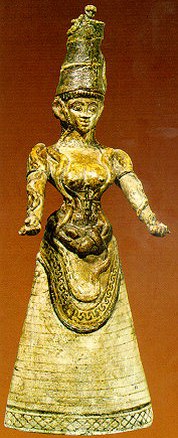
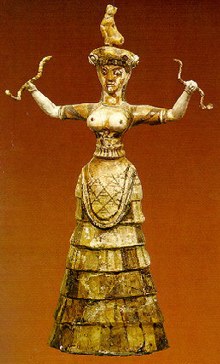
Snake goddess or priestess statues, found in Knossos, Crete
(Click here for the Snake goddess from the Boston Museum)
"...In Crete, the uncovering of the breasts was a sacred gesture, symbolizing the nourishing lifestream of the Mother. The Goddess was the One 'whose Godhead, single in essence, but of many forms, with varied rites and under many names, the whole earth reveres.' In later times her young son emerges as a deity, the leader and embodiment of the war-dancing Curetes (Korybantes). All the Cretan rites included ecstatic dancing and mystery; and in the Dionysian rituals these trance-inducing activities were not intended to prepare actual warriors, but to defend the spirit of the Mother's young son from the rising patriarchy."
The Great Cosmic Mother by Monica Sjoo & Barbara Mor
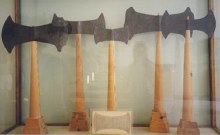
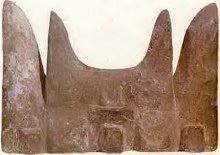
Double axes - Labryses and Horns of consecration
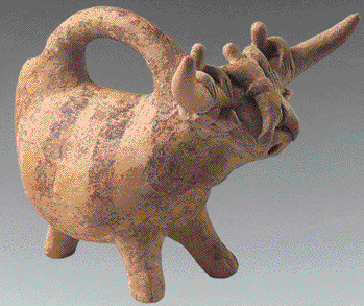
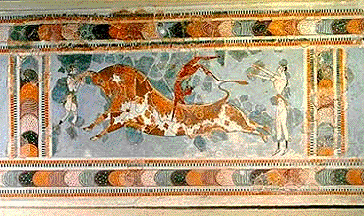
The scenes of "bull leaping" are popular depictions of Minoan ritual activities
Following pictures show the excavated and partly reconstructed palace of Knossos
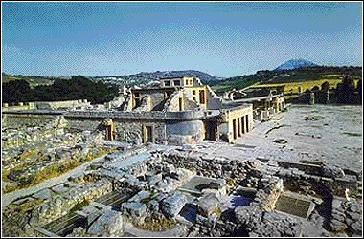
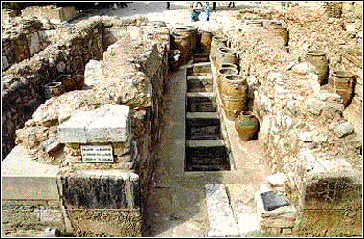
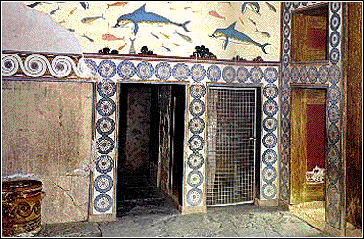
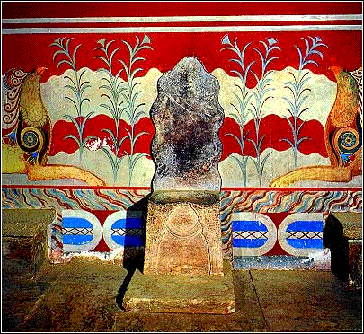
" ... Crete was the last, full flowering of matriarchal culture.
...The Cretans appear to have been gentle, joyous, sensuous and peaceloving. From the evidence of ruins, they maintained, like the Maltese islanders, at least one thousand years of culture unbroken by war. The only other people we know of with such a long peace record - e.g., those of the Indus Valley and of Southern India - were also Mother Goddess cultures."
The Great Cosmic Mother
Various scenes depicting probably different forms of Goddess worship:
Scene from the stone sarcophagus from Hagia Triada
Priestesses on the bench - clay model
Ritual dance - a scene on the gold ring
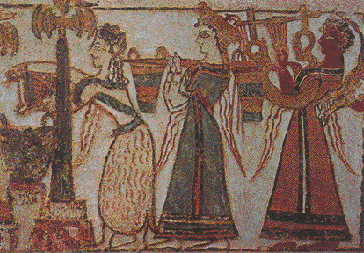
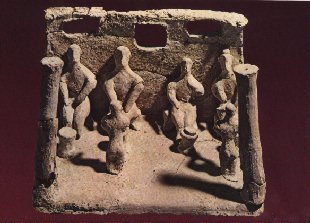
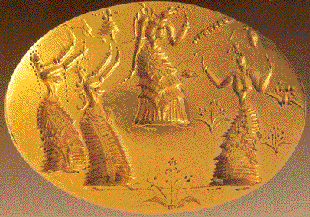
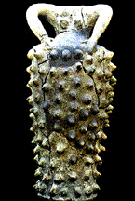
Clay female figurine from Hagia Triada
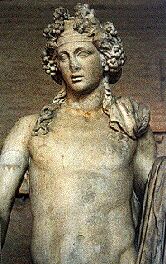
Dionysos (not so much Minoan - but ecstatic certainly)
"...In Cretan myth, Dionysus - called by some 'basely effeminate' - was the bisexual son of the Mother, raised as a girl among women.Throughout the Near East and the Aegean he was known by many names - Attis, Adonis, Tammuz, Damuzi, Osiris. Jesus was called Adonai, "Lord", after his erotic prototype, Adonis. As a Vegetation God he was ritually sacrificed, usually on a tree (prototype of the later crucifix). His flesh was eaten as bread, his blood drunk as wine - Dionysus is the God of Vine, Wine and Divine Intoxication.
The Great Cosmic Mother